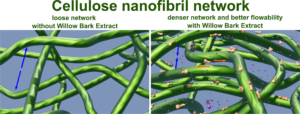Tuning the water interactions of cellulose nanofibril hydrogels using willow bark extract
Authors: Ngoc Huynh, Juan José Valle-Delgado, Wenwen Fang, Suvi Arola, Monika Österberg
Journal: Carbohydrate Polymers (2023)
Abstract
Cellulose nanofibrils (CNFs) are increasingly used as precursors for foams, films and composites, where water interactions are of great importance. In this study, we used willow bark extract (WBE), an underrated natural source of bioactive phenolic compounds, as a plant-based modifier for CNF hydrogels, without compromising their mechanical properties. We found that the introduction of WBE into both native, mechanically fibrillated CNFs and TEMPO-oxidized CNFs increased considerably the storage modulus of the hydrogels and reduced their swelling ratio in water up to 5–7 times. A detailed chemical analysis revealed that WBE is composed of several phenolic compounds in addition to potassium salts. Whereas the salt ions reduced the repulsion between fibrils and created denser CNF networks, the phenolic compounds – which adsorbed readily on the cellulose surfaces – played an important role in assisting the flowability of the hydrogels at high shear strains by reducing the flocculation tendency, often observed in pure and salt-containing CNFs, and contributed to the structural integrity of the CNF network in aqueous environment. Surprisingly, the willow bark extract exhibited hemolysis activity, which highlights the importance of more thorough investigations of biocompatibility of natural materials. WBE shows great potential for managing the water interactions of CNF-based products.

You may read the full paper here.
Tuning the water interactions of cellulose nanofibril hydrogels using willow bark extract










